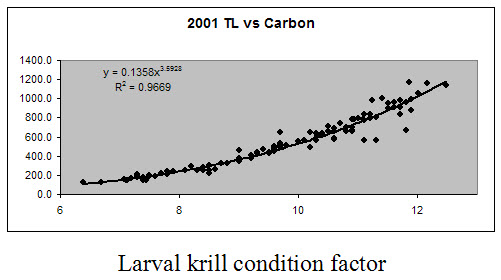Larval krill condition factor and C:N ratios from ARSV Laurence M. Gould LMG0106, LMG0205 in the Southern Ocean from 2001-2002 (SOGLOBEC project)
Project
Program
| Contributors | Affiliation | Role |
|---|---|---|
| Quetin, Langdon | University of California-Santa Barbara (UCSB) | Principal Investigator |
| Ross, Robin | University of California-Santa Barbara (UCSB) | Principal Investigator |
| Copley, Nancy | Woods Hole Oceanographic Institution (WHOI BCO-DMO) | BCO-DMO Data Manager |
The goal of the larval krill studies was to investigate the physiology and ecology of krill larvae associated with the pack ice and the microbial community on which they feed.
During LMG0106 we occupied two 4-5 day ice stations (Robert and Billy) and sampled several other ice floes opportunistically. We conducted 10 instantaneous growth rate experiments, and 4 whole body clearance time experiments to determine gut passage time (decline in pigment content over time). We also sampled larvae at two additional sites for initial body pigment content (whole body fluorescence), and at 4 sites for condition factor. The under-ice algal community was sampled at one site. Length and stage frequency determinations were also determined.
We occupied three time-series stations of approximately 1 week each, and in addition opportunistically sampled at times when other activities had priority. Our primary goal during the cruise was to occupy three ice camps or process stations with the intent of thoroughly studying the under-ice environment by SCUBA in conjunction with other projects working topside. (from cruise report LMG0205)
Using SCUBA techniques allowed us to collect larval krill as close as possible to their in situ condition. Larval krill were collected for time-based experimentation at the dive hole, for shipboard experiments and preserved for later analysis. Samples of the micro-zooplankton community were sampled with suction samplers to gain a better understanding of food available to the larvae relative to their distribution under the ice. In addition, at one of the process stations we were able to deploy drift nets through the dive holes to compare day/night differences in the zooplankton community at depths of 1 m and 10 m below the ice-water interface. (from cruise report LMG0205)
We collected enough krill for 12 Instantaneous Growth Rate (IGR) experiments, 15 collections for whole body (WBF) fluorescence, 11 collections for fecal pellet production (WBC), and 9 collections for condition factor. Measurements of length and stage frequency of the dive and net krill collections were done routinely. (from cruise report LMG0205)

Associated datasets:
larval_krill_sum - summary of experiments
larval_krill_gr - growth study
larval_krill_pig - whole body fluorescence and clearance
| File |
|---|
larval_krill_cf.csv (Comma Separated Values (.csv), 29.95 KB) MD5:650c8021d469e94423ea8a8e950bb505 Primary data file for dataset ID 3298 |
| Parameter | Description | Units |
| cruiseid | cruise identification | |
| year | year of experiment | |
| dive | dive or trawl number for krill collection | |
| length | total length of specimen | mm |
| C | carbon content | micrograms |
| N | Nitrogen content of specimen | milligrams |
| CN_ratio | ratio of Carbon to Nitrogen content of specimen | |
| cond_fact | condition factor calculated as Carbon per total length cubed | micrograms Carbon/Total Length ^3 |
| dry_wt | dry weight of the krill specimen | milligrams |
| Dataset-specific Instrument Name | Hand-net |
| Generic Instrument Name | Hand-held plankton net |
| Generic Instrument Description | A Hand-held plankton net is a fine-meshed net designed for sampling microzooplankton, mesozooplankton or nekton. |
| Dataset-specific Instrument Name | SCUBA |
| Generic Instrument Name | Manual Biota Sampler |
| Generic Instrument Description | "Manual Biota Sampler" indicates that a sample was collected in situ by a person, possibly using a hand-held collection device such as a jar, a net, or their hands. This term could also refer to a simple tool like a hammer, saw, or other hand-held tool. |
LMG0106
| Website | |
| Platform | ARSV Laurence M. Gould |
| Report | |
| Start Date | 2001-07-21 |
| End Date | 2001-09-01 |
LMG0205
| Website | |
| Platform | ARSV Laurence M. Gould |
| Report | |
| Start Date | 2002-07-29 |
| End Date | 2002-09-18 |
U.S. GLOBEC Southern Ocean (SOGLOBEC)
The fundamental objectives of United States Global Ocean Ecosystems Dynamics (U.S. GLOBEC) Program are dependent upon the cooperation of scientists from several disciplines. Physicists, biologists, and chemists must make use of data collected during U.S. GLOBEC field programs to further our understanding of the interplay of physics, biology, and chemistry. Our objectives require quantitative analysis of interdisciplinary data sets and, therefore, data must be exchanged between researchers. To extract the full scientific value, data must be made available to the scientific community on a timely basis.
U.S. GLOBal ocean ECosystems dynamics (U.S. GLOBEC)
U.S. GLOBEC (GLOBal ocean ECosystems dynamics) is a research program organized by oceanographers and fisheries scientists to address the question of how global climate change may affect the abundance and production of animals in the sea.
The U.S. GLOBEC Program currently had major research efforts underway in the Georges Bank / Northwest Atlantic Region, and the Northeast Pacific (with components in the California Current and in the Coastal Gulf of Alaska). U.S. GLOBEC was a major contributor to International GLOBEC efforts in the Southern Ocean and Western Antarctic Peninsula (WAP).
| Funding Source | Award |
|---|---|
| NSF Antarctic Sciences (NSF ANT) |
[ table of contents | back to top ]